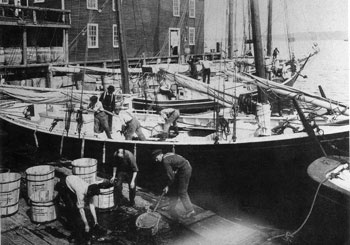B A C K T H E N
Markets 100 Years Ago

Rockland, circa 1913. A well-staged photo of activity atop a lobster car and aboard smacks of A.C. McLoon & Co. The firm’s auxiliary schooners Pauline McLoon and Adelle McLoon were built at Friendship in 1911 and 1913, respectively; the schooner Louise McLoon and the ketch-rigger Silas McLoon were built at East Boothbay in 1912 and 1913. The schooner in the foreground, and they schooner whose stern we glimpse at right, are likely two of the new vessels; the broad stern of the schooner in the background suggests that she is older.
It was calculated that the 247,000 lobsters shipped from Rockland by American Express from October 1, 1886, to March 1, 1887, would have extended some forty-seven miles if placed head to tail.1 With improved rail and steamer service in the ‘90s, Rockland’s prominence in the wholesale lobster business extended to even greater lengths. Thirty-three smacks then hailed from Knox County—likely all were from Rockland and Friendship.2 Live lobsters were routinely shipped to the Midwest in barrels, packed around a central column of ice. Barrels were topped off with seaweed. Holes bored in the bottoms drained out the lethal, fresh melt-water. Claws were not restrained.
A dealer’s lobster-storing car commonly held from two to three thousand lobsters. Cars were ordinarily partitioned into five transverse compartments; some were double-decked. Due to the borings of shipworms, cars lasted no more than five years. In 1893, a Friendship wholesaler lost 1,500 pounds of lobsters when, according to the Industrial Journal, a board became detached, “giving the crustaceans a chance to escape of which they readily availed themselves.”
McLoon smacks called regularly at such points as Seal Island, Wooden Ball Island, Criehaven, Matinicus, Metinic Island, Tenants Harbor, Spruce Head, Hewitt’s Island, Port Clyde, Medomak, Swan’s Island, Cape Split, Jonesport, Cutler, Cross Island, Starboard’s Creek, Little Kennebec River, and Buck’s Harbor. Smacks stationed at Stonington and Vinalhaven served as buying stations.5 The addition of the four large, new smacks allowed McLoon’s to expand operations to Nova Scotian waters, where for many years American smacks had the field largely to themselves. The smacking of Nova Scotian lobsters to Rockland, Portland, and Boston by Americans and also by Canadians effectively ended in 1956, when the Canadian National Railroad’s ferry Bluenose began service between Yarmouth, Nova Scotia, and Bar Harbor, greatly reducing the road mileage for trucks.
Smacks returning from Nova Scotia to prohibitionist Maine often engaged in rum smuggling, in large part to supply the alcohol demanded by lobster fishermen. McLoon supplied fishermen in isolated Maine and Nova Scotian out-ports with motor fuel, and while the firm is no longer in the lobster business it remains in the fuel business. McLoon trucks serve the Rockland area, while two small tankers supply petroleum products to Penobscot Bay island customers.
When the United States entered World War I the lobster industry was adversely affected by patriotic gestures of self-sacrifice. McLoon responded with classic Yankee shrewdness:
DO YOUR BIT
All those who are able, and whose disposition is to spend and not hoard money, should
EAT LOBSTERS
And thus conserve the necessities of life for those who are unable to afford the luxuries,
and by so doing
HELP WIN THE WAR.
Text by William H. Bunting from A Days Work, Part 2, A Sampler of Historic Maine Photographs, 1860 - 1920, Part II. Published by Tilbury House Publishers, Gardiner, Maine. 800-582-1899
